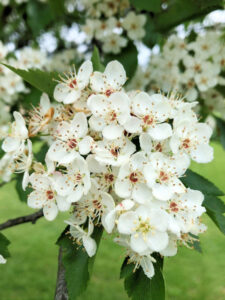
The Winter King Hawthorn (Crataegus viridis ‘Winter King’) is a stunning small, native tree that provides year-round beauty and ecological benefits. With showy spring flowers, vibrant fall foliage, persistent winter berries, and striking exfoliating bark, this tree is an exceptional choice for gardens, streetscapes, and smaller landscapes. Its resilience and mostly spineless nature make it a standout among hawthorn varieties, offering both aesthetic appeal and practical benefits.
A Tree for All Seasons
Spring: A Burst of Blooms
As winter fades, the Winter King Hawthorn awakens in spring with clusters of snow-white flowers that blanket its branches. These blooms attract butterflies and pollinators, adding life and movement to the garden while signaling the arrival of warmer days.
Summer: A Canopy of Green
During summer, the tree’s dark green foliage forms a lush, dense canopy that provides shade and structure. Its compact, rounded form makes it an excellent focal point in small gardens or a charming addition to mixed borders.
Fall: A Fiery Transformation
Come fall, the Winter King Hawthorn puts on a dazzling show as its foliage turns brilliant shades of purple and scarlet. This autumnal display rivals even the most colorful maples, adding warmth and depth to the landscape.
Winter: Berries and Bark for Visual Interest
True to its name, the Winter King reigns supreme even in winter. Its bright red berries, loved by songbirds, persist well into the cold months, providing a critical food source for wildlife and a striking contrast against bare branches. Adding to its beauty, the bark exfoliates on older stems, revealing a mix of grays, greens, and orange-browns, creating an intriguing, textured appearance that enhances the tree’s appeal even in the starkest months.
A Resilient and Versatile Choice
Winter King Hawthorn is a mostly spineless variety, making it easier to handle and plant in residential landscapes compared to other hawthorns, which are often heavily thorned. It is adaptable to various soil conditions, tolerates urban environments, and is resistant to common hawthorn diseases.
Its manageable size—growing 20–25 feet tall and 20–30 feet wide—makes it a perfect ornamental tree for small yards, gardens, and urban spaces. It thrives in full sun, requiring minimal maintenance beyond occasional pruning to shape its form.
Why Choose Winter King Hawthorn?
- An ideal small, native tree with four-season interest
- Snow white spring flowers attract butterflies and pollinators
- Brilliant fall foliage in shades of purple and scarlet
- Bright red fruit persists into winter and is loved by birds
- Mostly spineless, with only occasional small thorns
- Adaptable and disease-resistant, making it a low-maintenance choice
Planting and Care Tips
To ensure your Winter King Hawthorn thrives, plant it in a sunny location with well-drained soil. While it is drought-tolerant once established, watering during dry spells will keep it at its best. This tree requires minimal pruning, but if shaping is needed, prune in late winter or early spring before new growth begins.
A Worthy Addition to Any Landscape
Few trees offer the year-round beauty, resilience, and ecological benefits of the Winter King Hawthorn. Whether you’re looking to attract butterflies in spring, enjoy dazzling fall color, support songbirds in winter, or simply add a visually striking tree to your space, this exceptional variety delivers.
If you’re searching for a small, native tree with four-season interest, the Winter King Hawthorn is a choice that will shine in your garden for years to come.
